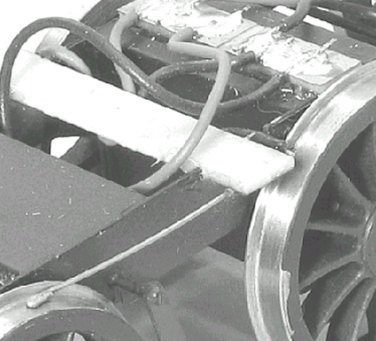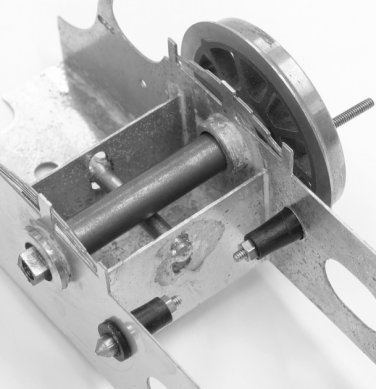With an electrical powered locomotive we have to find a way of taking onboard the electrical power from the track and transmitting it to the motor (in effect a power pickup system).
In 0 gauge there are two main options, sprung plunger pickups or wiper pickups. The choice of which is very much down to personal preference.
Modellers seem to be equally divided between those that like plungers and those that have a very strong dislike for them, reckoning that they always jamb or put too much braking pressure on the wheels and would never use anything other than wipers.
- Wire Wiper Pickups -
As the steel wheel tyres (rims) are touching the track these are electrically live and we need to take the power from the moving wheel tyre to a fixed point on the chassis.
With a wiper system lengths of spring wire or strip are soldered to insulated mounting plates on the chassis and made to bear onto the wheel tyre (tread or wheel back depending on preference and circumstance). So that as the wheel turns they wipe the surface collecting the power.
The wiper needs to be of a length such that as the wheel sets move across the chassis (side play) or even wobble slightly there is still sufficient movement and spring pressure for the pickup end of the wiper to remain in firm contact with the wheel tyre.
Fine insulated electrical wires than transmit the electrical current from the insulated mounting plates to the terminals of the motor.
- Parts Included in Kits -
Included in all my loco kits is material to make a wire wiper pickup system.
This consists of lengths of PCB (printed circuit board, thin copper sheet bonded to fibreglass board) to make the insulated mounting plates that can be glued (Araldite) across the chassis.
Lengths of 0.45mm half hard spring brass wire for making wipers (form a loop in the end of the wire and fill with solder to make a good wiping surface). And fine, flexible, red and black insulated electrical wire to take the electrical current to the motor.
These materials are relatively inexpensive and so including them does not raise the cost of a kit significantly. I occasionally use wipers (mainly for additional tender pickups on tender locos) and have had successful results fabricating them from these materials.

Wire wiper pickup system consisting of PCB strip glued across the chassis. Wiper wire made from 0.45mm brass wire (note how end is formed into loop to provide a good contact area on the wheel tread) and insulated electrical wire to take electrical power to the motor.
- Plunger Pickups -
The normal alternative to wiper pickups is sprung plungers. This system consists of a bullet nosed, spring loaded, brass, plunger, in an insulated plastic housing, fitted into a hole in the chassis so that it rubs onto the back of the wheel tyre. Power is then taken from a solder tag on the back of the plunger to the motor using thin flexible insulated wire.
I have tried to make provision for accommodating this system in my chassis designs by including pilot holes in the correct positions for mounting the plungers.
The idea is that if you are using plungers you open up the holes until the plungers are a nice push fit. If you are using wipers the pilot holes will not be noticed because the wheel tyre will cover them.

Plunger Pickups fitted into etched pilot holes in chassis so that the point of the plunger will bear onto the back of the steel wheel tyre.
- Slater's Plunger Pickups -
For myself I am a great fan of plunger pickups and have used them almost exclusively on all my locomotive chassis. I prefer to use Slater’s plunger pickups and if you are considering your first locomotive I suggest you give them a try first. Then if you don’t find that they suit, you can experiment with wipers using the materials included in the kit.

Slater,s plunger pickup components consisting of brass plunger, spring, plastic housing, nut, solder tag and locking nut. Also assembled pickup ready to be fitted into the chassis.
Full details of the Slater’s range can be found at
www.slatersplastikard.com
I have found that Slater’s plunger pickups require a little care in their preparation and fitting if they are to work reliably. I would suggest downloading the hints and tips sheet if you are considering using them.
Hints and Tips Sheet pdf File